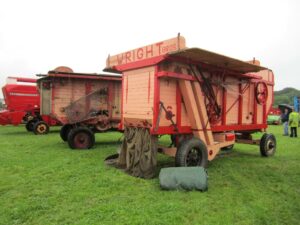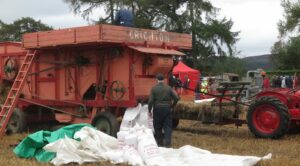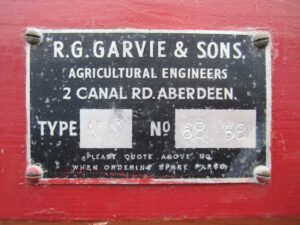Even though the combine harvester was making inroads into the harvesting of the grain crop, and revolutionising the handling of the crop, there continued to be a number of agricultural millwrights in Scotland. By this time they were generally well-established companies that had been making mills for a number of decades. They included:
Allan Brothers (Aberdeen) Ltd, Back Hilton Road, Aberdeen
Bertrams Ltd, Sciennes, Edinburgh
Clark & Sutherland, Millbrae (and general agricultural engineers), Smiddybrae Works, Kingswells, Aberdeenshire
J. Crichton, Turriff
Alexander Dey, 35 Church Street, Huntly, Aberdeenshire
Garvie & Scott, 41 Willowdale Place, Aberdeen
Alexander Dey, 35 Church Street, Huntly, Aberdeenshire
Garvie & Scott, 41 Willowdale Place, Aberdeen
Halley Brothers (Engineers) Ltd, Blinshall Street, Dundee
William Leslie, Kinellar, Aberdeenshire
J. & T. McWilliam, Lochans, Stranraer
A. Milne & Sons, 50 Jopp’s Lane, Aberdeen
John Scarth, Ayre Road, Kirkwall
Shearer Brothers Ltd, Maybank Works, Turriff, Aberdeebshire
James Smith, 8 Hill Street, Portsoy, Banffshire
D. M. Wallace & Sons Ltd, Bowmont, Kelso
Wright Bros (Boyne Mills), Boyne Mills, Portsoy, Banffshire
Andrew Young & Son, 51 High Craighall Road, Glasgow
The following are some snapshots of the histories of a small number of the millwright businesses:
By 1905 Wright Brothers of the Boyne Mills, Portsoy, made reapers, drillers and threshing mills. It was their threshing mills, and as a millwright that the company was especially renowned. By the late 1940s the business was undergoing significant changes. In early 1948 steps were being taken to incorporate it to become a company limited by guarantee; the company received its certificate of incorporation to become Wright Brothers (Boyne Mills) Ltd. The company continued in business until 1955. On 7 February the company passed an extraordinary resolution to voluntarily wind up the company. Its final winding up meeting was held on 17 October 1956.
In the mid nineteenth century the name of Crichton was associated with Lonmay, Aberdeenshire. The millwright business of James Crichton grew into a thriving and very successful business. By 1919 James Crichton took the step to re-locate his business to Strichen.
By 1919 his business was a well-known one. For the 1921 Highland Show, James advertised his business as a “well-known-maker”, also with “a large selection of the latest and most up-to-date threshers all in motion”. He had agents throughout Scotland, all of whom were well known implement and machine makers or machinery agents: Inverness (James Ferries & Co.), Perthshire and Forfarshire (Ford & Paterson, Broughty Ferry), Glasgow (P. & R. Fleming, 16 Graham Square), Linlithgow and surrounding district (A. Newlands & Sons Ltd), and the Lothians (W. R. Storie, Kelso). By 1922, the business had a depot at 60 Princes Street, Perth; by 1924, it was located at Horse Cross, Perth.
The business incorporated in 1925 to become Crichton’s (Strichen) Ltd, Strichen, and Perth. However, this change was short-lived, as it was voluntarily wound up from 1927. However, by April 1928 James Crichton had established himself as “James Crichton, engineer, Glasgow Road, Perth”, a name and address that continued to be known until at least 1931.
There were further changes. From 1934 James Crichton appears at as a millwright and engineer in Turriff. In the following year he advertised himself as “James Crichton Turriff … threshing machinery the outcome of 70 years’ experience”. By 1948 the business was referred to as “James Crichton, millwright and engineer, Chapel Street Works, Turriff, Aberdeenshire”. It was to move premises, and by 1953 the works were known as “Station Street Works”. That connection with Perth was not, however, lost. In 1949 the business was looking for business premises in Perth. By that time it had a number of long-service employees, such as William Finnie.
James Crichton died in September 1952. The displenishing sale of the stock and plant at the Station Street Works was held on 17 and 18 March 1953, also marking the closing down of the business. But that was not the end of the business or its name.
William Finnie, who had been the works manager for the last ten years acquired the Station Works and permission to carry on business from these premises as a millwright and engineer under the firm name of “James Crichton”, as well as the right to manufacture and supply spares to “Crichton” threshers. By 1969 the company was advertising as “James Crichton, millwrights, bodybuilders and engineers, Turriff”.
Shearer Brothers, Maybank Works, Railway Station, Turriff, later of Balmellie Street, Turriff, was a well-known thrashing mill maker in north-east Scotland. It undertook business from at least 1876 until 1972; on 18 July 1972 the company passed a special resolution to voluntarily wind up the company. The final winding up meeting was held on 29 August 1972.
The company undertook a number of trades and was an agricultural engineer, an agricultural implement maker, a machinery maker, a mechanical engineer, millwright and later a motor engineer. It was active in promoting its manufactures: exhibiting at the Highland Show from 1876 until 1939.
Robert G. Garvie set up his own business in Bon Accord Lane, Aberdeen, in 1895 to make and sell a range of agricultural implements and machines, including threshing mills. Before that time he was a highly esteemed implement maker.
When Robert G Garvie died in January 1921, the North British Agriculturist printed an obituary. It sets out his role in the Scottish agricultural implement making industry, as well as his own development within it:
“With much regret, we record the death on the 7th instant of Mr Robert G. Garvie, head of the firm of R. Garvie & Sons, agricultural engineers and millwrights, Aberdeen. Mr Garvie, who was in his 79th year, was the oldest member of the Scottishagricultural implement trade, and has worked hard right up to the end. He contracted a chill while on a journey to the north, and pneumonia cut him off after a few days’ illness. Apprenticed in his youth to joinery, he became a partner with his father in James Garvie & Sons, one of the best businesses of its kind in the north, and took a leading part in the introduction of wood-working machinery. In 1875 he became manager of the Northern Agricultural Implement Co., Inverness, and a year later joined the late William Anderson in the firm of Ben Reid & Co., Bon Accord Works. As the practical engineer of that establishment, he designed many labour-saving appliances and it was due to his personal supervision that the products of Ben Reid & Co. gained such a high reputation. On leaving that firm, Mr Garvie was engaged for some time by the late Provost Marshall, whom he assisted in the manufacture and improvement of the many machines turned out from Messrs Jack & Sons’ Maybole works. About twenty-five years ago he returned to Aberdeen and founded the present firm of R. Garvie & Sons, specialising in broad-cast sowing machines and threshing machines. From his extensive knowledge of iron and wood working, he was possibly most successful in the making of threshing mills, so much so, that of late years no firm supplied more threshers of the medium and small type required in the outlying districts of Scotland and Ireland. His business so developed that over a year ago he removed his workshops to the fiinely-equipped premises in Canal Road, Aberdeen, where he devoted much attention to the making of artificial manure distributors, chaff cutters, and hay cleaning appliances. Mr Garvie was a typical, hard-headed, hard-working Aberdonian, and everything which left his premises bore the stamp of efficiency, substantiality, and good finish. He will be missed by many from the national showcards as well as from the Ayr and Dublin gatherings, where he was a constant attender. Though of retiring disposition, this who came in contact with him found Mr Garvie to be a man of many parts. Well read, he took an interest in many things outside his business, and socially was a gentlemen whom to meet was to learn from and to know was to esteem and admire. He leaves two sons, Mr R. G. Garvie, junior, and Mr J. T. Garvie, who have both long been associated with him as partners in business.”




